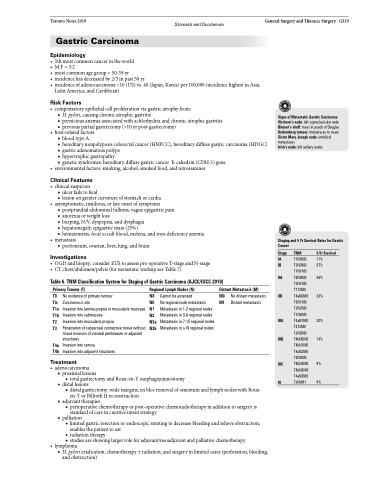Page 421 - TNFlipTest
P. 421
Toronto Notes 2019
Stomach and Duodenum
General Surgery and Thoracic Surgery GS19
Gastric Carcinoma
Epidemiology
• 5thmostcommoncancerintheworld
• M:F=3:2
• mostcommonagegroup=50-59yr
• incidencehasdecreasedby2/3inpast50yr
• incidenceofadenocarcinoma<10(US)vs.40(Japan,Korea)per100,000(incidencehighestinAsia,
Latin America, and Caribbean)
Risk Factors
• compensatoryepithelialcellproliferationviagastricatrophyfrom:
■ H. pylori, causing chronic atrophic gastritis
■ pernicious anemia associated with achlorhydria and chronic atrophic gastritis ■ previous partial gastrectomy (>10 yr post-gastrectomy)
• host-relatedfactors
■ blood type A
■ hereditary nonpolyposis colorectal cancer (HNPCC), hereditary diffuse gastric carcinoma (HDGC) ■ gastric adenomatous polyps
■ hypertrophic gastropathy
■ genetic syndromes: hereditary diffuse gastric cancer E-cahedrin (CDH-1) gene
• environmentalfactors:smoking,alcohol,smokedfood,andnitrosamines
Clinical Features
• clinicalsuspicion
■ ulcer fails to heal
■ lesion on greater curvature of stomach or cardia
• asymptomatic,insidious,orlateonsetofsymptoms
■ postprandial abdominal fullness, vague epigastric pain
■ anorexia or weight loss
■ burping, N/V, dyspepsia, and dysphagia
■ hepatomegaly, epigastric mass (25%)
■ hematemesis, fecal occult blood, melena, and iron-deficiency anemia
• metastasis
■ peritoneum, ovarian, liver, lung, and brain
Investigations
• OGDandbiopsy;considerEUStoassesspre-operativeT-stageandN-stage • CTchest/abdomen/pelvis(formetastaticworkupseeTable7)
Table 6. TNM Classification System for Staging of Gastric Carcinoma (AJCC/IUCC 2010)
Signs of Metastatic Gastric Carcinoma Virchow’s node: left supraclavicular node Blumer’s shelf: mass in pouch of Douglas Krukenberg tumour: metastases to ovary Sister Mary Joseph node: umbilical metastases
Irish’s node: left axillary nodes
Staging and 5 Yr Survival Rates for Gastric Cancer
Primary Tumour (T)
T0 No evidence of primary tumour Tis Carcinoma in situ
T1a Invasion into lamina propria or muscularis mucosae
T1b Invasion into submucosa
T2 Invasion into muscularis propria
T3 Penetration of subserosal connective tissue without
tissue invasion of visceral peritoneum or adjacent
structures
T4a Invasion into serosa
T4b Invasion into adjacent structures
Treatment
• adenocarcinoma
■ proximal lesions
Regional Lymph Nodes (N)
NX Cannot be assessed
N0 No regional node metastasis
N1 Metastasis in 1-2 regional nodes N2 Metastasis in 3-6 regional nodes N3a Metastasis in 7-15 regional nodes N3b Metastasis in ≥16 regional nodes
Distant Metastasis (M)
M0 No distant metastasis M1 Distant metastasis
Stage TNM
IA T1N0M0 IB T2N0M0 T1N1M0 IIA T3N0M0 T2N1M0 T1T2M0
IIB T4aN0M0 T3N1M0 T2N2M0 T1N3M0
IIIA T4aN1M0 T3T2M0 T2N3M0
IIIB T4bN0M0 T4bN1M0 T4aN2M0
T3N3M0 IIIC T4bN2M0 T4bN3M0 T4aN3M0
IV TxNxM1
5-Yr Survival
71% 57%
45% 33%
20% 14%
9% 4%
◆ total gastrectomy and Roux-en-Y esophagojejunostomy ■ distal lesions
◆ distal gastrectomy: wide margins, en bloc removal of omentum and lymph nodes with Roux- en-Y or Billroth II reconstruction
■ adjuvant therapies
◆ perioperative chemotherapy or post-operative chemoradiotherapy in addition to surgery is
standard of care in curative intent strategy ■ palliation
◆ limited gastric resection or endoscopic stenting to decrease bleeding and relieve obstruction, enables the patient to eat
◆ radiation therapy
◆ studies are showing larger role for adjuvant/neoadjuvant and palliative chemotherapy • lymphoma
■ H. pylori eradication, chemotherapy ± radiation, and surgery in limited cases (perforation, bleeding, and obstruction)


